Subtitle "Afrikaans" was produced by machine.Subtitle "አማርኛ" was produced by machine.Subtitle "العربية " was produced by machine.Subtitle "Ārāmāyâ" was produced by machine.Subtitle "azərbaycan dili " was produced by machine.Subtitle "беларуская мова " was produced by machine.Подзаглавието "България" е създадено от машина.সাবটাইটেল "বাংলা " মেশিন দ্বারা তৈরি করা হয়েছিল।Subtitle "བོད་ཡིག" was produced by machine.Subtitle "босански" was produced by machine.Subtitle "català" was produced by machine.Subtitle "Cebuano" was produced by machine.Subtitle "ગુજરાતી" was produced by machine.Subtitle "corsu" was produced by machine.Podtitul "Čeština" byl vytvořen automaticky.Subtitle "Cymraeg" was produced by machine.Subtitle "Dansk" was produced by machine.Untertitel "Deutsch" wurde maschinell erzeugt.Subtitle "Untertitel" was produced by machine.Ο υπότιτλος "Ελληνικά" δημιουργήθηκε αυτόματα.Subtitle "English" was produced by machine.Subtitle "Esperanto" was produced by machine.El subtítulo "Español" se generó automáticamente.Subtitle "Eesti" was produced by machine.Subtitle "euskara" was produced by machine.Subtitle "فارسی" was produced by machine.Subtitle "Suomi" was produced by machine.Le sous-titrage "Français" a été généré automatiquement.Subtitle "Frysk" was produced by machine.Subtitle "Gaeilge" was produced by machine.Subtitle "Gàidhlig" was produced by machine.Subtitle "Galego" was produced by machine.Subtitle "Schwizerdütsch" was produced by machine.Subtitle "هَوُسَ" was produced by machine.Subtitle "Ōlelo Hawaiʻi" was produced by machine.Subtitle "עברית" was produced by machine.Subtitle "हिन्दी" was produced by machine.Subtitle "Mẹo" was produced by machine.Subtitle "Hrvatski" was produced by machine.Subtitle "Kreyòl ayisyen " was produced by machine.Subtitle "Magyar" was produced by machine.Subtitle "Հայերեն" was produced by machine.Subtitle "Bahasa Indonesia " was produced by machine.Subtitle "Asụsụ Igbo " was produced by machine.Textun"Íslenska" var framkvæmt vélrænt.Sottotitoli "Italiano" sono stati generati automaticamente.字幕は"日本語" 自動的に生成されました。Subtitle "Basa Jawa" was produced by machine.Subtitle "ქართული" was produced by machine.Subtitle "қазақ тілі " was produced by machine.Subtitle "ភាសាខ្មែរ" was produced by machine.Subtitle "ಕನ್ನಡ" was produced by machine.Subtitle "한국어" was produced by machine.Subtitle "कोंकणी語" was produced by machine.Subtitle "کوردی" was produced by machine.Subtitle "Кыргызча" was produced by machine.Subtitle " lingua latina" was produced by machine.Subtitle "Lëtzebuergesch" was produced by machine.Subtitle "Lingala" was produced by machine.Subtitle "ພາສາ" was produced by machine.Subtitle "Lietuvių" was produced by machine.Subtitle "Latviešu" was produced by machine.Subtitle "fiteny malagasy" was produced by machine.Subtitle "te reo Māori" was produced by machine.Subtitle "македонски јазик" was produced by machine.Subtitle "malayāḷaṁ" was produced by machine.Subtitle "Монгол хэл" was produced by machine.Subtitle "मराठी" was produced by machine.Subtitle "Bahasa Malaysia" was produced by machine.Subtitle "Malti" was produced by machine.Subtitle "မြန်မာစာ " was produced by machine.Subtitle "नेपाली" was produced by machine.Ondertitels "Nederlands" machinaal geproduceerd.Subtitle "Norsk" was produced by machine.Subtitle "chiCheŵa" was produced by machine.Subtitle "ਪੰਜਾਬੀ" was produced by machine.Podtytuł "Polska" został utworzony przez maszynę.Subtitle "پښتو" was produced by machine.Legenda "Português" foi gerada automaticamente.Subtitle "Română" was produced by machine.Subtitle "Язык жестов (Русский)" was produced by machine.Субтитры "Pусский" были созданы машиной.Subtitle "Kinyarwanda" was produced by machine.Subtitle "सिन्धी" was produced by machine.Subtitle "Deutschschweizer Gebärdensprache" was produced by machine.Subtitle "සිංහල" was produced by machine.Subtitle "Slovensky" was produced by machine.Subtitle "Slovenski" was produced by machine.Subtitle "gagana fa'a Samoa" was produced by machine.Subtitle "chiShona" was produced by machine.Subtitle "Soomaaliga" was produced by machine.Subtitle "Shqip" was produced by machine.Subtitle "србски" was produced by machine.Subtitle "Sesotho" was produced by machine.Subtitle "Basa Sunda" was produced by machine.Undertext "Svenska" är maskinell skapad.Subtitle "Kiswahili" was produced by machine.Subtitle "தமிழ்" was produced by machine.Subtitle "తెలుగు" was produced by machine.Subtitle "Тоҷикй" was produced by machine.Subtitle "ภาษาไทย" was produced by machine.ንኡስ ኣርእስቲ "ትግርኛ" ብማሽን እዩ ተፈሪዩ።Subtitle "Türkmençe" was produced by machine.Subtitle "Tagalog" ay nabuo sa pamamagitan ng makina.Subtitle "Türkçe" was produced by machine.Subtitle "татар теле" was produced by machine.Subtitle "Українська " was produced by machine.ذیلی عنوان "اردو" مشین کے ذریعہ تیار کیا گیا تھا۔Subtitle "Oʻzbek" was produced by machine.Subtitle "Tiếng Việt" was produced by machine.Subtitle "Serbšćina" was produced by machine.Subtitle "isiXhosa" was produced by machine.Subtitle "ייִדיש" was produced by machine.Subtitle "Yorùbá" was produced by machine.Subtitle "中文" was produced by machine.Subtitle "isiZulu" was produced by machine.
kla.TV accepts no liability for defective translation.kla.TV accepts no liability for defective translation.kla.TV accepts no liability for defective translation.kla.TV accepts no liability for defective translation.kla.TV accepts no liability for defective translation.kla.TV accepts no liability for defective translation.kla.TV не носи отговорност за некачествен превод.অপর্যাপ্ত অনুবাদের জন্য kla.TV কোন দায় বহন করে না।kla.TV accepts no liability for defective translation.kla.TV accepts no liability for defective translation.kla.TV accepts no liability for defective translation.kla.TV accepts no liability for defective translation.kla.TV accepts no liability for defective translation.kla.TV accepts no liability for defective translation.kla.TV nenese žádnou odpovědnost za chybné překlady.kla.TV accepts no liability for defective translation.kla.TV accepts no liability for defective translation.kla.TV übernimmt keine Haftung für mangelhafte Übersetzung.kla.TV accepts no liability for inadequate translationΗ kla.TV δεν φέρει καμία ευθύνη για ανεπαρκή μετάφραση.kla.TV accepts no liability for defective translation.kla.TV accepts no liability for defective translation.kla.TV no se hace responsable de traducciones incorrectas.kla.TV accepts no liability for defective translation.kla.TV accepts no liability for defective translation.kla.TV accepts no liability for defective translation.kla.TV accepts no liability for defective translation.kla.TV n'assume aucune responsabilité en cas de mauvaise traduction.kla.TV accepts no liability for defective translation.kla.TV accepts no liability for defective translation.kla.TV accepts no liability for defective translation.kla.TV accepts no liability for defective translation.kla.TV accepts no liability for defective translation.kla.TV accepts no liability for defective translation.kla.TV accepts no liability for defective translation.kla.TV accepts no liability for defective translation.kla.TV accepts no liability for defective translation.kla.TV accepts no liability for defective translation.kla.TV accepts no liability for defective translation.kla.TV accepts no liability for defective translation.kla.TV nem vállal felelősséget a hibás fordításértkla.TV accepts no liability for defective translation.kla.TV accepts no liability for defective translation.kla.TV accepts no liability for defective translation.kla.TV tekur enga ábyrgð á áræðanleika þýðingarinnarKla.TV non si assume alcuna responsabilità per traduzioni lacunose e/o errate.Kla.TV は、不適切な翻訳に対して一切の責任を負いません。kla.TV accepts no liability for defective translation.kla.TV accepts no liability for defective translation.kla.TV accepts no liability for defective translation.kla.TV accepts no liability for defective translation.kla.TV accepts no liability for defective translation.kla.TV accepts no liability for defective translation.kla.TV accepts no liability for defective translation.kla.TV accepts no liability for defective translation.kla.TV accepts no liability for defective translation.kla.TV accepts no liability for defective translation.kla.TV accepts no liability for defective translation.kla.TV accepts no liability for defective translation.kla.TV accepts no liability for defective translation.kla.TV accepts no liability for defective translation.kla.TV accepts no liability for defective translation.kla.TV accepts no liability for defective translation.kla.TV accepts no liability for defective translation.kla.TV accepts no liability for defective translation.kla.TV accepts no liability for defective translation.kla.TV accepts no liability for defective translation.kla.TV accepts no liability for defective translation.kla.TV accepts no liability for defective translation.kla.TV accepts no liability for defective translation.kla.TV accepts no liability for defective translation.kla.TV accepts no liability for defective translation.kla.TV aanvaardt geen aansprakelijkheid voor foutieve vertalingen.kla.TV accepts no liability for defective translation.kla.TV accepts no liability for defective translation.kla.TV accepts no liability for defective translation.kla.TV nie ponosi odpowiedzialności za wadliwe tłumaczenie.kla.TV accepts no liability for defective translation.kla.TV não se responsabiliza por traduções defeituosas.kla.TV accepts no liability for defective translation.kla.TV accepts no liability for defective translation.kla.TV не несет ответственности за некачественный перевод.kla.TV accepts no liability for defective translation.kla.TV accepts no liability for defective translation.kla.TV accepts no liability for defective translation.kla.TV accepts no liability for defective translation.kla.TV accepts no liability for defective translation.kla.TV accepts no liability for defective translation.kla.TV accepts no liability for defective translation.kla.TV accepts no liability for defective translation.kla.TV accepts no liability for defective translation.kla.TV nuk mban asnjë përgjegjësi për përkthime joadekuate.kla.TV accepts no liability for defective translation.kla.TV accepts no liability for defective translation.kla.TV accepts no liability for defective translation.Kla.TV tar inget ansvar för felaktiga översättningar.kla.TV accepts no liability for defective translation.kla.TV accepts no liability for defective translation.kla.TV accepts no liability for defective translation.kla.TV accepts no liability for defective translation.kla.TV accepts no liability for defective translation.kla.TV ንዝኾነ ጉድለት ትርጉም ዝኾነ ይኹን ሓላፍነት ኣይቅበልን እዩ።kla.TV accepts no liability for defective translation.kla. Walang pananagutan ang TV sa mga depektibong pagsasalin.kla.TV accepts no liability for defective translation.kla.TV accepts no liability for defective translation.kla.TV accepts no liability for defective translation.kla.TV عیب دار ترجمہ کے لیے کوئی ذمہ داری قبول نہیں کرتا ہے۔kla.TV accepts no liability for defective translation.kla.TV accepts no liability for defective translation.kla.TV accepts no liability for defective translation.kla.TV accepts no liability for defective translation.kla.TV accepts no liability for defective translation.kla.TV accepts no liability for defective translation.kla.TV accepts no liability for defective translation.kla.TV accepts no liability for defective translation.
This is a modal window.
The media could not be loaded, either because the server or network failed or because the format is not supported.
Dangerous effects of electromagnetic fields - Interview with Professor Dr. Olle Johansson -
Invisible electromagnetic fields pose immense dangers to life and limb. Because they are downplayed and denied, the harmfulness is unknown to the majority of people. It ranges from clearly proven effects on human reproduction to the extinction of the insect population, which is essential for survival par excellence.
[continue reading]

|
Olle Johansson's Research: |
|---|
Dangerous effects of electromagnetic fields - Interview with Professor Dr. Olle Johansson -
Download broadcast and attachments in the wanted quality: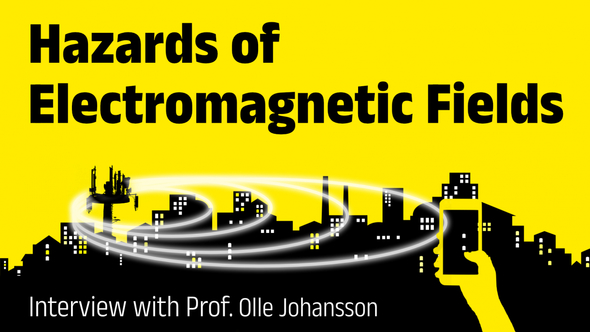
Useage rights:
Standard-Kla.TV-Licence
Topics A-Z
Enter a word for search or use the alphabetic search-order



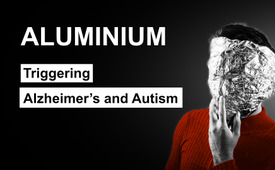


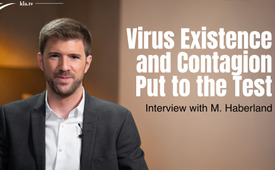


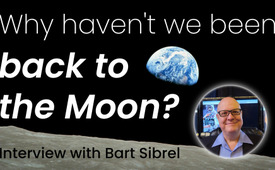
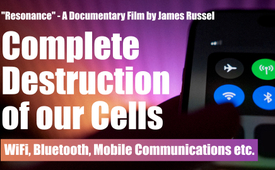
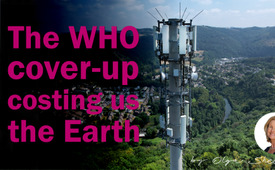
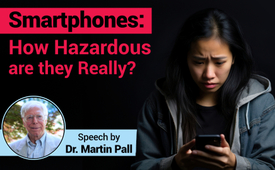
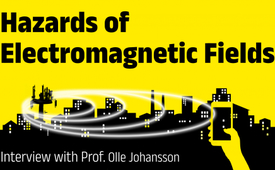

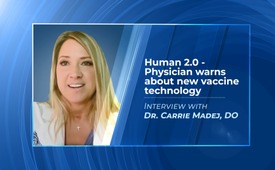

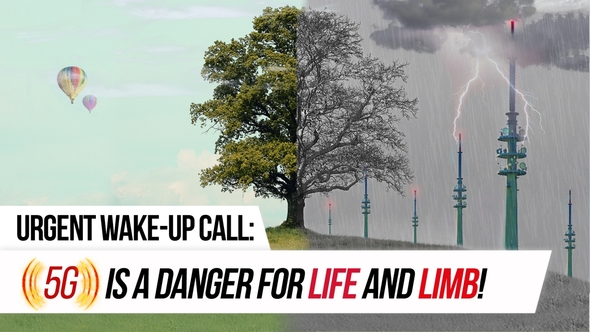
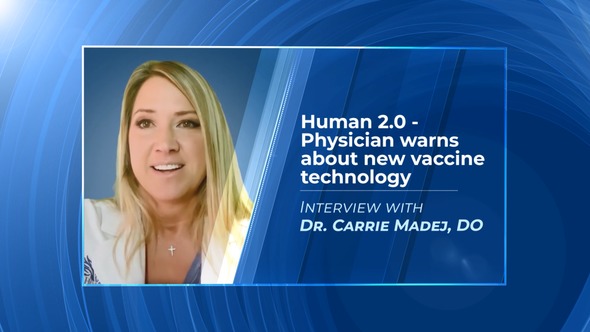



18.03.2023 | www.kla.tv/25466
In the following interview with Prof. Dr. Johansson, you will learn what he has to say as an authority on electromagnetic fields. Dr. Johansson was Associate Professor and Head of the Department of Experimental Dermatology, Division of Neuroscience, at the prestigious Karolinska Institute in Stockholm, a WHO reference body. He is one of the world's highest authorities on what is known about the effects of power frequency and radio frequency electromagnetic fields and their deleterious effects on human, animal and environmental health. He began researching this topic more than 30 years ago and has since published hundreds of scientific papers. The World Health Organization has officially classified these electromagnetic fields and their radiation exposure as carcinogenic. Dan: Today we are honored to speak with professor Olle Johansson from Sweden. Dr. Johansson thank you very much for joining us for this interview. Olle Johansson: Well, thank you so much. It’s a great honor to participate this evening and to talk about some of the issues that I know you’re interested in. Dan: Please, let’s begin, tell us a little bit about your-self and your research in harmful radiati-on. Olle Johansson: Okay, I entered the medical school at the Ka-rolinska Institute in Stockholm, Sweden in 1972. And in 1973 I joined a research group, headed by assistant professor Tomas Hökfelt and we start-ed to study the central and peripheral nervous system and its content of various transmitter- or messenger molecules. And the years passed, I presented my PhD thesis which was about so-called peptide containing nerve cells in the cen-tral and peripheral nervous system. And, of course the central nervous system is the brain and spinal cord and the peripheral nervous sys-tem are all the nerves out in your body. And after that it's customary at any university to pro-file yourself, meaning that you would choose a completely different topic, not to continue to sort of compete with your supervisor and your previous research group. And I thought that I would move from various experimental animals into human beings which is, as you know, rather rare as an experimental animal. And then we came to study, for instance human skin, human oral mucosa and also vagina mucosa. And that meant that we were very limited when it came to material to study. But we went along and studied normal healthy skin and it turned out that we can add, quite a big number of papers. People were very interested, and soon also clini-cal dermatologists came to us and said: Hey, couldn’t you investigate, for instance psoriasis or malignant melanomas of the skin. And yes, of course we were very interested in it and this forms the platform which made us in a unique pool pole position I would say, because at the end of the 1970’s it was reported, first from Norway and the United States about people that had started to use the newly introduced per-sonal computers with their computer screens and getting skin irritations, skin rashes, pricking pain, redness, heat sensations and what not. And we formed, or introduced a term, named “screen dermatitis”, telling, that the screen had in some way interacted with the human skin and given these reactions. Just as if they had been out in the sun but it was in the mid-winter and as you know, here in Sweden there isn’t very much sun at all, in December for instance. And still they got this kind of sun rash light irritation of the skin. So, our working hypothesis was that the radiation, the electromagnetic fields in some way, may be in concert together with chemicals being emitted from these gadgets as well, would interact with the human skin and alarming it in such a way so it would react just as we would react to sunshine, for instance. My colleagues, this was very odd, you know, they didn’t look upon it at all in that way. They said instead that persons that believed they had some skin reac-tions due to the computer screen radiation, they were just post-menopausal women, for in-stance. That was the first explanation that was given by clinical medical doctors. Then soon also men arrived on the scene, so then people quick-ly started to say: no no no, it was not about the post-menopausal phenomenon. It is, of course, because these people they have rather low level of education. When they are introduced to new gadgets they get stressed, they are afraid, and therefore they get these kinds of psychosomatic reactions. Dan: Pure hypochondria Olle Johansson: Yeah, exactly! And then soon here in Sweden and elsewhere, you had pro-fessors, lawyers, politicians also telling the world that, no we have also these reactions in spite of the fact that we have a very high level of education. And then these clinical experts and I would call the experts within quotation marks, they very quickly said, no, no, no, no, we actu-ally meant the opposite: it is, of course, the people with a high education, and they expect too much from their computer and their printer and when it gets jammed and it doesn’t work then they get pissed and angry and stressed, and therefore they get these skin reactions and all of that. Dan: Why are they so quick to dismiss out of hand the possibility of a chemical or radiation damage and go towards the mental thing? Olle Johansson: Ya, that became really a center point question for me because I realized that these were no explanations but trials to just shove these peo-ple under the carpet and get rid of them. And I couldn’t understand who had actually said that we should do it like this. I was not used as a sci-entist and of course these medical doctors were not scientifically trai-ned in the same way as I was, but I was still fascinated to see. And they also talked about imagination, for instance. They talked about Pavlovian Conditioning and that maybe it was just because of the psychosocial climate at your workplace and then, finally, what these clini-cians arrived at, was something that even I could say: Yeah, that’s plausible – namely that it was actually your fault. People like re-porters, journalists, people making videos, pod-casts and whatever. They would make people start to think that, well maybe I also have these reac-tions. Dan: Right, I would bet then that you have probably been accused of increasing the psycho-somatic reactions with your activism. Olle Johansson: Ya, especially the mass media and in science that’s called a mass media driven psychosis. And as a scientist in the neuroscience field I said, yeah, that’s possible, but it’s very easy to study, to see if that’s the case. So, we took actually rats and exposed them to the same type of electro-magnetic fields. To make a very long story short we saw exactly the same cellular and molecular reaction patterns in spite of the fact that rats don’t listen to you and me. They don’t read newspapers, they don’t listen to radio, they don’t look at television – and still they got the same reaction. And then I understood that: no, all these explanations we-re not worth anything. It is a radiation damage, and we should have as a working hypothesis. And of course, and I may be going ahead a little bit now, but that also opened up to a much, much, much bigger field, namely the field of adverse health and biological reac-tions and effects to artificial electromagnetic fields. Right, from your cellphone, your WIFI router, your wireless baby alarm, your wireless smart meter, etc. Yeah, and I mean practically everything that you would have in your vicinity will irradiate you with artificial electromagnetic fields and very importantly to remember: these fields that you, for instance, sit in right now, and I do that as well, and that could be from the lights in your room, from the cables from the computer, from whatever you have, from the cellphone. All these electromagnetic fields are at a high exposure level and the smallest or lowest increase compared to natural background is ac-tually power frequent magnetic fields which you get from your cabling, indoors or outdoors. And compared to the natural background, the fields are only 100 million times higher. Dan: : It’s interesting you say that because I have, I have argued this with some people and they pull out it’s look, the natural radiation you get from the sun, from other things in the environment, it’s just as strong. So you’re saying: absolutely not, we’re getting way more from these artificial things. Olle Johansson: Oh yeah, oh yeah, and also, you know, it’s im-portant that you consider, of course, the sun, for instance, as you know, the sun for living matter on this planet is really very dangerous. So most species avoid the sun as a plague, really very much. And the rest of us that have to go out-side, we have a skin, or if you are a tree, a cor-tex. And in it you have pigment that will keep out a little bit of the sun rays. But if I, for in-stance, in a few months, go out in the spring sun here, I will be burnt. I will get a sun burn and an inflammatory reaction. Because of the natural sun, which has been here always, and life on the planet has had 3.8 billion years to adapt to it and still hasn’t. And so you really avoid it as a plague, you know. And, so that’s an argument, and also importantly to understand the artificial fields and signals are very artificial. They are very different-ly when it comes to pulsation, modulation, fre-quency content, polarisation, etc. etc. etc. And, so they are very, very different. Dan: And which devices would you put at the top of the…dangerous, or the potentially most danger-ous devices? And I’m thinking about microwave ovens, computers, smart meters, simple cell-phones, smartphones, WIFI networks, blue-tooth, wireless headphones, power lines, tele-phone lines, radio waves, X-rays, CT-scan ma-chines, MRI’s, living near a nuclear powerplant. Which one of these would you say is the ones we really have to pay attention to? Olle Johansson: Yes, it’s very difficult to really discuss different gadgets and compare them. Of course, a nuclear powerplant is very safe until it isn’t any longer and it explodes. Yeah, so that’s important. But I would say it like this: Gadgets that you keep very close to or on your body will automatically give rise to very very, much higher exposures than gadgets that are far nough away. And many of the gadgets that we think about here people never need, hopefully you and I will never have to go through a CT-scan for instance. So we will never be exposed to it. And even for a patient that will be single cases short exposures and the gain is, of course, overriding eventual risks at this kind of investigation. But then, of course, it was down to things that – cellphones. You also men-tioned, like microwave ovens. Again, most peo-ple use it very rarely and for short times. But what I’m thinking about is, for instance, young people working at hamburger joints. They often have industrial microwave ovens, heating a hamburger within seconds, at a very high rate of power and they often have them right in front of their foreheads. And it’s interesting to read about, since a few years back – or not so few maybe, 10 or 20 years back, about new types of forehead damages to the brain in young people. And I tried to ask medical doctors: did you ask them what kind of medical profession they were – oh, sorry: occupational profession they were in. Have they worked, for instance, at a ham-burger restaurant? But they had never done that questioning, so they didn’t know. Dan: What is the main danger of being so close to these gadgets? Having a cellphone in your pock-et, this close to your crutch. What is the risk of that? Having it on you all day long, if not cancer? Olle Johansson: You know, the point is, can you remember, I said I worked my whole life at the Karolinska Insti-tute which is famous for handing out the nobel price in physiology or me-dicine. So having worked there, we learned to work according to a model that is called a con-sensus model and to always attack different questions accordingly. And you point to a very interesting thing here, if you look out into the reality, I said before, you don’t see any incidence increases of brain tu-mors. You see a dramatic distraction and reduc-tion of sperm cells. And then it’s not so far-fetched to start thinking: hm, why do we see that? And are there experi-ments having been done where sperm cells have been allowed to be exposed to cellphones? Yes, we have. And what happened then? They didn’t like it. They were harmed and their mor-tality decreased!!! And their morphology was damaged. And so on and so on and so on, you know. And I’m the first to say: well, these studies are not complete. They need to be replica-ted. And for many years I tried at the Karolinska Institute, which is actually a reference organ for the World Health Organi-zation when it comes to male fertility issues, to be allowed to ex-pose sperm cells to cellphone radiation and see what would happen. And I was always met with a “no, thank you”. We should not do that. And that was, of course, stressful. And I still think we must replicate and see, could that be one of the culprits behind this dramatic reduc-tion and the following reduction in fertility. And I read just like a week ago an American sci-entist pointed to that maybe already at 2050 couples can only get pregnant through artificial insemination where the good sperm cells are selected and joined together with a good, healthy egg cell. And that’s not the way it used to be a few years back. So there you have a big big issue and which is, with all due respect for cancer patients, but it’s so much bigger. It im-pacts so many more and don’t forget: we are not the only species with testicles and I got re-ports this year from England about a reduction in sperm cell quality, also in dogs used for breed-ing. And, so you see, and it’s natural then to start thinking: could there be an environ-mental factor which are the same for the dogs and for you and me? And, sorry to be a little bit blunt here, but we ruled out, for instance, dog food, because I don’t think you and I eat dog food. We maybe can rule out a lot of other things that we are not having in common with a dog. But then we would have a list of things, that, of course, we are having in common with a dog. For instance, exposure from manmade electromagnetic fields. Dan: Tell us about your experiments with the woman on the train. I heard it in another interview. That was a great story. It’s a short one. If you can tell us it. And then at the end I would like to know why you were warning her. Olle Johansson: Last year in March I went on a commuter train here in Stockholm. And since no one knows who I am, I always take the sort of possibility to edu-cate and inform pe-ople. For instance, when I was in the United States of America in 2019, I had a lengthy lecture for a cab driver. He was extremely interested. Dan: Which city where you in? Olle Johansson: In Philadelphia at that time. We went a very long distance and at the end he refused to ac-cept any payment because, yeah, he thought the lecture was so interesting, so important. But then coming back to the commuter train: I en-tered it and sat down next to a very posh lady in her 60’s. And I leant forward and said to her: I see you have one of these smartphones in your hand. Do you know that the World Health Or-ganization in Geneva in Switzerland has actually cancer classified the radiation that comes from your phone and goes to it. And she went, I think you say “ballistic”. She was very, yeah, really angry with me, yelled at me and said that I could practically go to a hot place. And I should mind my own business and I didn’t know anything. So I should just keep my mouth shut. And then I said: well, well, wait, you have this smartphone. Couldn’t you please use the google function and just google WHO, brain tumor and cellphone. And she did it and went silent for, like a minute or two. And then she slowly looked up at me and said: well, it’s all here. You’re completely right, she said. It’s all here, I see it, I read it. And now I get angry again, she said. Not at you but I get angry at my own parliament, government, and health authorities. Why have they not in-formed me about this? You see I’m not only a mother but also a grandmother. And last week, she said, I gave my 12-year-old granddaughter a new cellphone and now I regret it. And by then I had to leave the train. So I don’t know how her story progressed after it. But I feel I need to put some mental seeds into the soil of the brain of people and maybe tuck them away from what they are doing otherwise, surfing the internet and so on and start thinking. So that’s about it. Dan: Yes, a little street evangelism there, right? Olle Johansson: Ya ya, exactly. Dan: You know, that’s the first time I heard that story. I was thinking of the time, I think you were in Stockholm on public transportation and there was a woman with her husband and she was searching for baby cribs. Do you remember that one? Olle Johansson: No… Dan: : It might have been a few years ago. Searching for a bay crib and she was telling her husband that, don’t worry, we’re in Sweden, we’re not going to have any problems… Olle Johansson: Oh, right. Ya, ya, ya, exactly, and they were talk-ing about getting one of these baby alarms and I think her husband had some questions. And she just snapped him off and said: well, we are in Sweden. They would never allow anything dan-gerous. And then again, I leant forward and started informing them about the electromag-netic fields and signals and what they meant possibly for the little baby. And my recommen-dation was, of course, to keep the baby next to themselves instead of monitoring it via one of these wireless baby monitors. And so, again… and you know I always felt that in a democracy like the United States or in Sweden, Canada or whatever, as a consumer citizen, as a constitu-ent you shouldn’t have to teach yourself every-thing. If I go into a store and buy a can of green peas, they should be safe for me. I shouldn’t have to read through all the background infor-mation and all the additives and the coloring and the chemicals and so on. I should just be very, very safe in that situation. And therefore, I think it’s, how do you say, dishonorable not to inform people that, okay, you’re going to buy, for in-stance, a baby monitor – but think about this. And of course that gadget is sold as being safe. I mean, it’s not even discussed in a store if it’s safe or not. Even people working there believe in their product. And they don’t have any con-cerns about: could this impact sperm cells, ba-bies, pollinators, bacteria, plant cells? No, they don’t think about it, you know. Dan: Is the reduction in the insect population due to increased radiation in society? Olle Johansson: That’s one of my main focal points in the sci-ence. We are trying to perform, if you can, I have even a fundraiser call link that people can use if they want to support us. And I can tell you we need the support very badly because it’s very difficult to get funding, especially when you’re retired, as I am. And we’re trying to in-vestigate exactly this. And again, we’re doing replications because there are already scientists that have shown that pollinators like honey bees – they don’t like cellphone radiation, and cell-phone gadgets. And just to fill in on that you probably know that last year it was reported from the United States that more than 90% of your bumble bees are gone. And this year it is reported from Canada that more than 90% of their honey bees are gone. And in Europe we have a much – in quotation mark - “lower” num-ber than this. We only have lost like 80% of all pollinators. So this is a big thing. Much much bigger than any presidential election or world cup in football. Because without the pollinators, then the food stores will be pretty empty. And there is a very famous photo online. You can find it on the internet, from an American food store. You see these fabulous shelves with fruits, nuts, vegetables. And then they remove all the things dependent on pollinators, like honey bees and bumble bees and then the store is practically empty. And if that doesn’t arouse fear in peo-ple, well, then I don’t know what. Dan: Yes, yes, well, I will encourage our viewers right now to look in the show description below and we will include that link to your organization that’s doing the research. Olle Johansson: Thank you! Dan: Yes, well Dr. Johansson, it’s been really wonder-ful speaking to you. I enjoyed this inter-view and I can’t wait to see it go up on Kla.TV. Thank you very much! Olle Johansson: Well, the same, thank you so much. Dan: Thank you so much, too!
from ug/avr
https://www.scinexx.de/news/technik/who-handystrahlung-moeglicherweise-krebserregend/
https://noxtak.com/dr-olle-johansson-one-of-the-biggest-researchers-of-emf-effects-in-health-2/